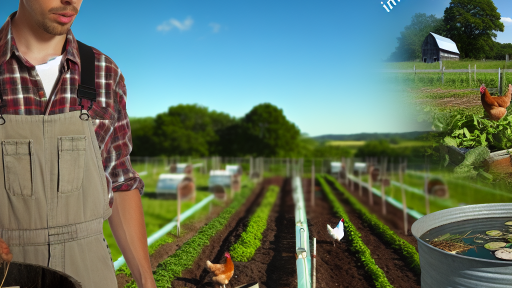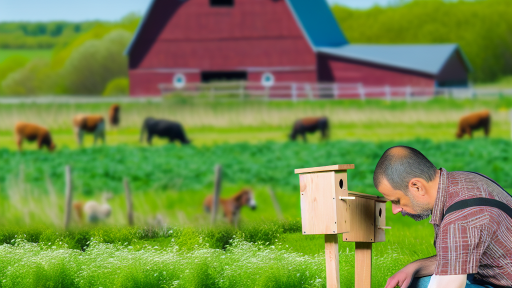Introduction to Crop Rotation
Definition of Crop Rotation
Crop rotation involves alternating the types of crops grown on the same land over different seasons.
This practice can enhance soil health and fertility.
It also helps in managing pests and diseases more effectively.
Why Crop Rotation is Important
A key benefit of crop rotation is its ability to maintain soil nutrients.
By rotating crops, farmers can prevent nutrient depletion.
Additionally, diverse crops improve soil structure and support a healthy ecosystem.
Environmental Benefits
Implementing crop rotation leads to reduced dependence on chemical fertilizers.
It promotes biodiversity, benefiting local wildlife and pollinators.
Moreover, crop rotation can help mitigate soil erosion by keeping soil covered.
Economic Advantages
Crop rotation can increase yields over time by improving soil conditions.
This practice often results in lower costs related to pest management and fertilization.
Farmers gain a competitive edge through sustainable practices that appeal to eco-conscious consumers.
Benefits of Crop Rotation for Soil Health and Fertility
Enhancing Soil Structure
Crop rotation improves soil structure significantly.
This practice helps to avoid soil compaction.
Additionally, different crops promote varied root systems.
Transform Your Agribusiness
Unlock your farm's potential with expert advice tailored to your needs. Get actionable steps that drive real results.
Get StartedThese systems contribute to better aeration and water infiltration.
Reducing Soil Erosion
Crop rotation plays a vital role in minimizing soil erosion.
Cover crops and rotation stabilize the soil surface.
Roots from diverse plants hold soil particles together.
This reduces the likelihood of nutrient loss through runoff.
Improving Soil Fertility
Different crops have unique nutrient requirements.
Rotating crops replenishes essential nutrients in the soil.
For instance, legumes enrich the soil with nitrogen.
This natural fertilization reduces the need for chemical fertilizers.
Breaking Pest and Disease Cycles
Crop rotation disrupts the lifecycle of pests and diseases.
This practice helps to manage pest populations effectively.
For example, rotating non-host crops can reduce disease prevalence.
Consequently, this leads to healthier crops with higher yields.
Promoting Biodiversity
Crop rotation encourages on-farm biodiversity.
This diversity leads to a resilient ecosystem.
Moreover, beneficial insects and microorganisms thrive in varied environments.
Such resilience aids in pest control and soil fertility.
Common Crop Rotation Practices Used by Eco-Friendly Farmers
Understanding Crop Rotation
Crop rotation involves alternating different crops in the same area across seasons.
This practice helps improve soil health and fertility.
By continually changing crops, farmers can disrupt pest and disease cycles.
Furthermore, diverse crops enhance the ecosystem’s resilience.
Legume Rotation
Including legumes in crop rotation is highly beneficial.
Legumes, such as beans and peas, fix nitrogen in the soil.
This natural fertilization supports the growth of subsequent crops.
Showcase Your Farming Business
Publish your professional farming services profile on our blog for a one-time fee of $200 and reach a dedicated audience of farmers and agribusiness owners.
Publish Your ProfileFor instance, planting corn after legumes can yield better results.
Cover Cropping
Cover cropping serves multiple purposes in eco-friendly farming.
Farmers plant cover crops during off-seasons to protect the soil.
These crops, like clover and rye, prevent erosion and improve soil structure.
Additionally, cover crops can suppress weeds effectively.
Three Sisters Method
The Three Sisters is an ancient farming technique still popular today.
This method involves growing corn, beans, and squash together.
Each plant benefits the others: corn provides support for beans.
Meanwhile, squash leaves provide shade and reduce weed growth.
Sequential Planting
Sequential planting maximizes productivity and soil use.
Farmers alternate between main crops and quick-growing plants.
For example, they may plant radishes after harvesting a main crop.
This practice allows continuous cultivation throughout the year.
Crop Diversity Benefits
Maintaining crop diversity fosters resilience against pests and diseases.
It also reduces reliance on chemical inputs and fertilizers.
Diverse crops can adapt better to changing environmental conditions.
Consequently, farmers achieve healthier ecosystems and better yields.
See Related Content: Biodiversity’s Role in Soil Health
Identifying Key Crops for Rotation
Importance of Crop Rotation
Crop rotation enhances soil health and fertility.
It prevents crop diseases and pest infestations.
This strategy also optimizes nutrient usage in the soil.
Legumes in Crop Rotation
Legumes play a crucial role in sustainable farming.
They fix nitrogen in the soil, improving soil quality.
Common legumes include beans, peas, and lentils.
Prioritizing legumes helps reduce the need for synthetic fertilizers.
Grains for Sustainable Farming
Grains contribute essential carbohydrates to the rotation.
Popular choices include wheat, corn, and barley.
These crops can enhance soil structure and moisture retention.
Moreover, they offer diversity in crop production.
Vegetables to Consider
Vegetables provide valuable vitamins and minerals.
Examples like carrots, lettuce, and tomatoes thrive in diverse rotations.
They also support beneficial insect populations on farms.
Including vegetables helps create a balanced farming ecosystem.
Creating a Rotation Plan
Start by assessing your soil and climate conditions.
Choose a mix of legumes, grains, and vegetables.
Develop a multi-year plan to maximize efficiency.
Adjust the plan based on crop performance and soil tests.
Delve into the Subject: Soil Moisture Conservation Tips for Farmers
How Crop Rotation Affects Pest and Disease Management
Influence on Pest Populations
Crop rotation disrupts the life cycles of pests.
By alternating crops, farmers can reduce pest populations significantly.
Showcase Your Farming Business
Publish your professional farming services profile on our blog for a one-time fee of $200 and reach a dedicated audience of farmers and agribusiness owners.
Publish Your ProfileFor instance, rotating legumes with grains can confuse pests that prefer specific crops.
Moreover, some crops attract beneficial insects that prey on harmful pests.
As a result, pest resilience diminishes over time.
Impact on Soil Health
Healthy soil improves a farm’s pest and disease resistance.
Crop rotation enhances soil fertility and structure.
Rotated crops improve microbial diversity in the soil.
This diversity allows the soil to better suppress diseases.
Consequently, healthier crops grow, which are more resistant to pests.
Minimizing Disease Incidence
Different crops can host various pathogens.
Rotating dissimilar crops helps break the cycles of crop-specific diseases.
For instance, following a susceptible crop with a resistant one can prevent disease outbreaks.
This practice decreases the reliance on chemical treatments.
Thus, it promotes more sustainable farming practices.
Examples of Effective Crop Rotation
Many farmers have successfully adopted crop rotations for pest management.
Corn and soybeans are a common rotation duo in the Midwestern U.S.
Similarly, tomato followed by a cover crop like buckwheat minimizes tomato disease incidences.
Furthermore, rotation strategies can differ based on local conditions.
Farmers should tailor their strategies to specific pest and disease challenges.
Learn More: Innovative Waste Management Ideas for Farmers
Integrating Organic Matter
Cover Crops
Cover crops enhance soil health by adding organic matter.
They protect the soil from erosion during off-season periods.
Leguminous cover crops fix nitrogen in the soil.
This improves nutrient availability for subsequent crops.
Examples include clover, vetch, and rye.
Farmers can easily establish these crops before the main planting season.
Cover crops also suppress weeds and reduce pests.
Consequently, they lower the need for chemical herbicides.
Additionally, they promote healthy soil microbiomes.
Green Manures
Green manures are crops grown specifically to be incorporated into the soil.
This practice enriches the soil with organic matter.
Common green manure crops include buckwheat and forage radish.
Incorporating green manures helps maintain soil structure.
This method improves water retention during dry periods.
Furthermore, green manures can suppress soil-borne diseases.
By planting them, farmers can reduce reliance on fertilizers.
Ultimately, this strategy enhances the overall fertility of the land.
Benefits of Organic Matter Integration
Integrating organic matter leads to increased soil fertility.
This enhances crop productivity and resilience to climate changes.
Soils rich in organic matter hold more water and nutrients.
Consequently, they require less irrigation and chemical amendments.
Showcase Your Farming Business
Publish your professional farming services profile on our blog for a one-time fee of $200 and reach a dedicated audience of farmers and agribusiness owners.
Publish Your ProfileMoreover, farmers can expect improved yields over time.
In the long run, this practice supports sustainable farming goals.
Increased biodiversity results from a healthier soil ecosystem.
Farmers should consider these benefits when planning crop rotations.
You Might Also Like: Sustainable Crop Rotation Plans for Modern Farmers

Planning a Rotation Schedule
Understanding the Importance of Timing
Timing is crucial in crop rotation.
A well-planned schedule maximizes yield and soil health.
Identify the growing seasons for your crops.
Rotate crops based on their specific needs and timelines.
Selecting the Right Crops
Crop selection impacts soil fertility and pest management.
Choose crops that complement each other nutritionally.
Consider the nitrogen-fixing properties of legumes.
Incorporate diverse crops to improve soil structure.
Creating a Rotation Cycle
Design a cycle that spans several years.
Limit the repetition of the same crop.
Assign certain crops to specific fields annually.
Utilize cover crops between main crops to protect soil.
Monitoring and Adjusting the Schedule
Regularly monitor plant health and soil conditions.
Adjust the rotation based on observed results.
Take notes on yields and pest issues for future planning.
Be flexible to change based on weather patterns.
Case Studies: Successful Implementation of Crop Rotation in Eco-Friendly Farms
Green Acres Organic Farm
Green Acres Organic Farm adopted crop rotation five years ago.
They focused on alternating legumes and grains each season.
This technique improved their soil health significantly.
Additionally, it increased their overall crop yield.
Farmers at Green Acres reported less reliance on chemical fertilizers.
They noted enhanced biodiversity in their fields as well.
Sunnyview Farms
Sunnyview Farms implemented crop rotation two years ago.
They rotated corn, beans, and cover crops annually.
This method reduced pest infestations by promoting natural predators.
Moreover, their soil retained moisture better during drought periods.
Sunnyview Farms also experienced a 30% increase in profits.
Customers appreciated their commitment to sustainable practices.
Maple Hill Community Garden
Maple Hill Community Garden serves its local community with crop rotation.
They cultivate various vegetables in a three-year rotation cycle.
This approach maximizes nutrient efficiency from the soil.
Residents participated in educational workshops on sustainable farming.
They learned the importance of crop diversity and soil health.
Community members expressed pride in their eco-friendly gardening efforts.
Lessons Learned Across the Board
These farms demonstrate the benefits of crop rotation.
Showcase Your Farming Business
Publish your professional farming services profile on our blog for a one-time fee of $200 and reach a dedicated audience of farmers and agribusiness owners.
Publish Your ProfileThey highlight the enhancement of soil health and biodiversity.
Additionally, they show a marked decrease in chemical pesticide use.
Implementing crop rotation can also boost farm profitability.
Ultimately, these case studies inspire farmers worldwide.
Challenges and Solutions in Implementing Crop Rotation
Understanding Common Obstacles
Many farmers face challenges when implementing crop rotation.
Time constraints often limit their ability to plan effectively.
Moreover, insufficient knowledge about crop compatibility poses a significant barrier.
In some cases, farmers have limited access to diverse seed varieties.
This limitation can hinder the success of rotation strategies.
Addressing Knowledge Gaps
Education plays a vital role in overcoming these knowledge gaps.
Workshops and training sessions can enhance farmers’ understanding.
Additionally, online resources can provide valuable insights into best practices.
Collaboration with agricultural experts can also yield beneficial results.
Enhancing Seed Diversity
Access to varied seed options is crucial for effective crop rotation.
Local agricultural cooperatives can help facilitate this access.
Additionally, farmers should explore partnerships with seed banks.
Such initiatives can foster greater biodiversity in farming systems.
Creating a Supportive Policy Environment
Government policies influence the adoption of sustainable practices.
Subsidies for crop rotation initiatives can encourage farmer participation.
Furthermore, regulations should support research on diversified agriculture.
These policies can create a more sustainable farming landscape.
Utilizing Technology to Streamline Implementation
Technology can significantly ease the process of adopting crop rotation.
Farm management software allows for better planning and tracking.
Furthermore, precision agriculture can optimize planting schedules.
As a result, farmers can make more informed decisions.
The Future of Crop Rotation in Sustainable Agriculture
Enhancing Soil Health
Crop rotation significantly enhances soil health over time.
Planting different crops helps break pest and disease cycles.
This method encourages nutrient diversity within the soil.
Moreover, it supports beneficial microorganisms that promote plant growth.
Improving Crop Yields
Implementing crop rotation can lead to improved crop yields.
Diverse planting nourishes the soil and reduces dependency on fertilizers.
This practice increases the resilience of crops to environmental changes.
As a result, farmers experience fewer losses due to pests and diseases.
Contributing to Biodiversity
Crop rotation supports a diverse ecosystem on the farm.
It attracts various beneficial insects and wildlife.
With different crops, farmers can create habitats that enhance biodiversity.
In turn, this leads to more stable and productive farming systems.
Supporting Climate Resilience
Climate change poses numerous challenges for agriculture.
Crop rotation offers a strategy to adapt to these changing conditions.
Diverse cropping systems can withstand extreme weather events better.
Showcase Your Farming Business
Publish your professional farming services profile on our blog for a one-time fee of $200 and reach a dedicated audience of farmers and agribusiness owners.
Publish Your ProfileFurthermore, they reduce reliance on chemical inputs, enhancing sustainability.
Encouraging Innovative Practices
The future of crop rotation will involve innovative agricultural practices.
Farmers are now exploring intercropping and cover cropping methods.
These techniques further enrich soil and combat soil erosion.
Thus, they contribute to the long-term success of agricultural systems.
Implications for Sustainable Agriculture
The ongoing evolution of crop rotation reflects its importance in sustainable farming.
This approach ensures agricultural viability for future generations.
Farmers who adopt these practices will enhance productivity and sustainability.
As awareness grows, more farmers will embrace crop rotation strategies.
Consequently, this will lead to more resilient agricultural landscapes.
Additional Resources
Sustainable Agriculture & Earth-Friendly Farming to Combat Food …
What is Sustainable Agriculture? | Union of Concerned Scientists




